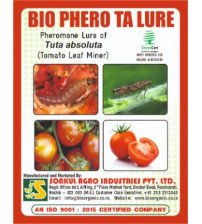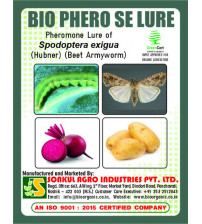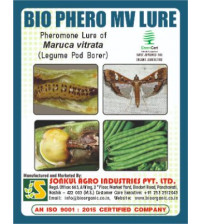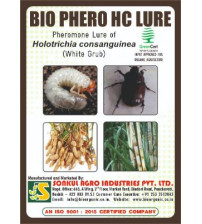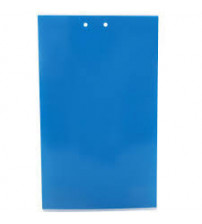Shopping Cart
0 item(s) - Rs 0.00Combo Pack of Bio Phero BC (Melon Fruit Fly) Lure & Glass trap set (Pack of 10 Pieces)
Brand: Sonkul Agro Industries Pvt. Ltd.
Categories: Insects Traps, Pheromone Lures & Traps,
Availability: In Stock
Cash on delivery Availability: NO
Combo Pack of Bio Phero BC (Melon Fruit Fly) Lure & Glass trap set (Pack of 10 Pieces)
Technical Name of Lure: Bacterocera CucurbitaeIdentification:
Egg: The egg is pure white, about 2 mm long, elliptical, nearly flat on the ventral surface, and more convex on the dorsal. Eggs often are somewhat curved.
Larva: The larva has three instars. The larva is white, except when its appearance is altered by the color of the food within the alimentary canal. The larva has a typical fruit fly larval shape - cylindrical-maggot shape, elongate, anterior end narrowed and somewhat curved ventrally, with anterior mouth hooks, ventral fusiform areas, and flattened caudal end. The last instar larva ranges from 7.5 to 11.8 mm in length. The larva of the melon fly is particularly distinctive in having a dark sclerotized horizontal line below the spiracular region on the caudal end, with a curved ridge on each side of it.
Adult: The adult melon fly is 6 to 8 mm in length. Distinctive characteristics include its wing pattern, its long third antennal segment, the reddish yellow dorsum of the thorax with light yellow markings, and the yellowish head with black spots.
Life Cycle:
Development from egg to adult under summer conditions requires from 12 to 28 days, according to the individual and host and weather conditions. The developmental periods may be extended considerably by cool weather. The preoviposition period lasted 7 to 26 days and the oviposition period 39 to 95 days. A single hardy female may lay as many as 1,000 eggs. Eggs generally are laid in young fruit, although they are laid also in succulent stems of many host plants, in cavities made with the aid of a sharp ovipositor. Only the ripe fruit of some hosts is attacked. Pupation normally occurs in the soil, usually beneath the host, at a depth of up to 2 inches. Adults may live more than a year. Adults feed primarily upon juices of host plants, nectar, and honeydew secreted by various kinds of insects. There may be as many as eight to 10 generations a year.
Nature of Damage:
Larval feeding damage in fruits is the most damaging. Mature attacked fruits develop a water-soaked appearance. Young fruits become distorted and usually drop. The larval tunnels provide entry points for bacteria and fungi that cause the fruit to rot. These maggots also attack young seedlings, succulent tap roots of watermelon, and stems and buds of host plants such as cucumber, squash, and others. The economic importance of the melon fly cannot be evaluated entirely from the standpoint of the direct damage to the various crops affected. Quarantine laws aimed at preventing the entry and establishment of melon flies in areas where it does not occur often reduce the export potential of locally grown crops.
Target Plants:
Watermelon, Muskmelon, Pumpkin, Bottle Gourd, Cucumber, Ridged Gourd, Bitter Gourd (Karle), Tinda, Parwal, etc.
Usage Instruction:
- Cut open this pack and slide the lure piece outside. Do not touch the lure with bare hands.
- Fix this lure properly in the trap by sliding it into the hole provided in the funnel trap.
- Replace the lure at the recommended duration.
- Wash hands thoroughly before and after handling the trap and lure.
- Discard used lure by burning or burying underground.
Trap to be used: Fruit Fly Trap
Number of traps per Acre: 8 to 10
Life of Lure: 60 Days
Manufactured, Packed & Dispatched By: Sonkul Agro Industries
Click here to see Guarantee / Warranty of this Product.
Barrix Yellow Roll Magic Sticker Chromatic Trap
Rs 569.00
Barrix Yellow Roll Magic Sticker Chromatic Trap Click here to see Organic Certificates of Barrix .....
Barrix Catch Fruit Fly Trap Set
Rs 173.00
Min. Quantity: 5
Barrix Catch Fruit Fly Trap Set Click here to see Organic Certificates of Barrix (Trap) Descri.....
Barrix Catch Vegetable Fly Trap Set
Rs 173.00
Min. Quantity: 5
Barrix Catch Vegetable Fly Trap Set Click here to see Organic Certificates of Barrix (Trap) &nbs.....
Barrix Catch Fruit Fly Lure
Rs 79.00
Min. Quantity: 6
Barrix Catch Fruit Fly Lure Click here to see Organic Certificates of Barrix (Trap) De.....
Barrix Catch Vegetable Fly Lure
Rs 79.00
Min. Quantity: 6
Barrix Catch Vegetable Fly Lure Click here to see Organic Certificates of Barrix (Trap) .....
Barrix Magic Sticker - Yellow Sheet
Rs 37.00
Min. Quantity: 40
Barrix Magic Sticker - Yellow Sheet Click here to see Organic Certificates of Barrix (Trap) De.....
Barrix Magic Sticker - Blue Sheet
Rs 37.00
Min. Quantity: 40
Barrix Magic Sticker - Blue Sheet Click here to see Organic Certificates of Barrix (Trap) Desc.....
Barrix Magic Sticker - Yellow Sheet Mini
Rs 21.50
Min. Quantity: 30
Barrix Magic Sticker - Yellow Sheet Mini Click here to see Organic Certificates of Barrix (Trap) .....
Barrix Magic Sticker - Blue Sheet Mini
Rs 21.50
Min. Quantity: 30
Barrix Magic Sticker - Blue Sheet Mini Click here to see Organic Certificates of Barrix (Trap) D.....
Barrix Magic Sticker Chromatic Trap - Combo Pack 2 Yellow & 1 Blue
Rs 108.00
Min. Quantity: 3
Barrix Magic Sticker Chromatic Trap - Combo Pack 2 Yellow & 1 Blue Description: Specially de.....
Housefly Domo Trap and 1 Set of Lure
Rs 399.00
Min. Quantity: 2
Housefly Domo Trap and 1 Set of Lure Description: House Fly (Musca domestica) are good car.....
IPM Trap
Rs 17.00
Min. Quantity: 20
IPM Trap Description: IPM trap Pheromone trap is designed for different fruit fly species in v.....
Max Plus Trap
Rs 100.00
Min. Quantity: 5
Max Plus Trap Description: Pheromone traps utilize insect hormones that simulate the type of sce.....
Funnel Trap
Rs 34.00
Min. Quantity: 10
Funnel Trap Description: The insects mass trapping (Mass trapping) is an ecological method, spec.....
Delta Trap
Rs 60.00
Min. Quantity: 10
Delta Trap Description: The Delta trap is a long lasting and water resistant device that can be .....
Yellow Sticky Trap - 22 cm x 28 cm
Rs 45.00
Min. Quantity: 10
Yellow Sticky Trap - 22 cm x 28 cm Description: Yellow sticky traps are a common method for moni.....
Yellow Sticky Trap - 22 cm x 33 cm
Rs 50.00
Min. Quantity: 10
Yellow Sticky Trap - 22 cm x 33 cm Description: Yellow sticky traps are a common method for moni.....
Melon Fly Trapper
Rs 699.00
Melon Fly Trapper Description: This trapper box is complete combo for 1 acre. Pest Identifica.....
Blue Sticky Trap - 22 cm x 28 cm
Rs 35.00
Min. Quantity: 10
Blue Sticky Trap - 22 cm x 28 cm Description: The Blue trap has some important advantages. As we.....
Blue Sticky Trap - 22 cm x 33 cm
Rs 40.00
Min. Quantity: 10
Blue Sticky Trap - 22 cm x 33 cm Description: The Blue trap has some important advantages. As we.....
Glue Trapper 100 ml
Rs 249.00
Min. Quantity: 4
Glue Trapper 100 ml Description: Glue Trapper works under the integrated pest management supported.....
Glue Trapper 250 ml
Rs 449.00
Min. Quantity: 2
Glue Trapper 250 ml Description: Glue Trapper works under the integrated pest management supported.....
Glue Trapper 500 ml
Rs 799.00
Glue Trapper 500 ml Description: Glue Trapper works under the integrated pest management supported.....
Rato'n Trapper
Rs 45.00
Min. Quantity: 10
Rato'n Trapper Description: The Rato’n Trapper is a trapping all kind of RAT/Mouse in .....
ECO Sticky Trap pack of 25 pieces
Rs 250.00
ECO Sticky Trap pack of 25 pieces Description: ECO sticky traps are a advance method for monitor.....
ECO Sticky Trap pack of 25 pieces
Rs 235.00
Min. Quantity: 2
ECO Sticky Trap pack of 25 pieces Description: ECO sticky traps are a advance method for monitor.....
ECO Sticky Trap pack of 25 pieces
Rs 205.00
Min. Quantity: 4
ECO Sticky Trap pack of 25 pieces Description: ECO sticky traps are a advance method for monitor.....
Barrix Magic Glue (With 40 covers) 300 ml
Rs 489.00
Barrix Magic Glue (With 40 covers) 300 ml Barrix magic glue is a pest monitoring and a pest control.....
Barrix Magic Sticker - White Sheet
Rs 37.00
Min. Quantity: 40
Barrix Magic Sticker - White Sheet Description: To support farmers in monitoring their crops for.....
Sonkul Jumbo Yellow Sticky Trap - 6 x 8 inches (10 Pieces)
Rs 149.00
Sonkul Jumbo Yellow Sticky Trap - 6 x 8 inches (10 Pieces) Description: Effective, Eco Friendl.....
Sonkul Jumbo Yellow Sticky Trap - 6 x 8 inches (25 Pieces)
Rs 229.00
Sonkul Jumbo Yellow Sticky Trap - 6 x 8 inches (25 Pieces) Description: Effective, Eco Friendl.....
Sonkul Jumbo Blue Sticky Trap - 6 x 8 inches (10 Pieces)
Rs 149.00
Sonkul Jumbo Blue Sticky Trap - 6 x 8 inches (10 Pieces) Description: Effective, Eco Friendly,.....
Sonkul Jumbo Blue Sticky Trap - 6 x 8 inches (25 Pieces)
Rs 229.00
Sonkul Jumbo Blue Sticky Trap - 6 x 8 inches (25 Pieces) Description: Effective, Eco Friendly,.....
Sonkul Jumbo Blue Sticky Trap - 12 x 8 inches (10 Pieces)
Rs 249.00
Sonkul Jumbo Blue Sticky Trap - 12 x 8 inches (10 Pieces) Description: Effective, Eco Friendly.....
Sonkul Jumbo Blue Sticky Trap - 12 x 8 inches (25 Pieces)
Rs 389.00
Sonkul Jumbo Blue Sticky Trap - 12 x 8 inches (25 Pieces) Description: Effective, Eco Friendly.....
Sonkul Jumbo Yellow Sticky Trap - 12 x 8 inches (10 Pieces)
Rs 249.00
Sonkul Jumbo Yellow Sticky Trap - 12 x 8 inches (10 Pieces) Description: Effective, Eco Friend.....
Sonkul Jumbo Yellow Sticky Trap - 12 x 8 inches (25 Pieces)
Rs 389.00
Sonkul Jumbo Yellow Sticky Trap - 12 x 8 inches (25 Pieces) Description: Effective, Eco Friend.....
Sonkul Bio Sticky Glue 350 grams
Rs 339.00
Sonkul Bio Sticky Glue 350 grams Description: Effective, Eco Friendly, Chemical Free Managemen.....
Combo Pack of Bio Phero HA (Cotton Bollworm) Lure & Funnel trap set (Pack of 10 Pieces)
Rs 589.00
Combo Pack of Bio Phero HA Helicoverpa Armigera Lure (Cotton Bollworm) & Funnel trap set (P.....
Combo Pack of Bio Phero SL (Leaf eating Caterpillar) Lure & Funnel trap set (Pack of 10 Pieces)
Rs 629.00
Combo Pack of Bio Phero SL Spodoptera Litura Lure (Leaf eating Caterpillar) & Funnel trap s.....
Combo Pack of Bio Phero EV (Spotted Bollworm) Lure & Funnel trap set (Pack of 10 Pieces)
Rs 659.00
Combo Pack of Bio Phero EV Earias Vittella (Spotted Bollworm) Lure & Funnel trap set (.....
Combo Pack of Bio Phero PG (Pink Bollworm) Lure & Funnel trap set (Pack of 10 Pieces)
Rs 599.00
Combo Pack of Bio Phero PG Pectinophora Gossypiella Lure (Pink Bollworm) & Funnel trap set .....
Combo Pack of Bio Phero LO (Brinjal Shoot and Fruit Borer) Lure & Delta trap set (Pack of 10 Pieces)
Rs 599.00
Combo Pack of Bio Phero LO (Brinjal Shoot and Fruit Borer) Lure & Delta trap set (Pack of 10 Pie.....
Combo Pack of Bio Phero OR (Rhinoceros Beetle) Lure & Bucket trap set (Pack of 5 Pieces)
Rs 1,899.00
Combo Pack of Bio Phero OR (Rhinoceros Beetle) Lure & Bucket trap set (Pack of 5 Pieces) .....
Combo Pack of Bio Phero RF (Red Palm Weevil) Lure & Bucket trap set (Pack of 5 Pieces)
Rs 2,049.00
Combo Pack of Bio Phero RF (Red Palm Weevil) Lure & Bucket trap set (Pack of 5 Pieces) T.....
Combo Pack of Bio Phero CI (Sugarcane Early Shoot Borer) Lure & Delta trap set (Pack of 10 Pieces)
Rs 499.00
Combo Pack of Bio Phero CI (Sugarcane Early Shoot Borer) Lure & Delta trap set (Pack of 10 Piece.....
Combo Pack of Bio Phero SI (Rice Yellow Stem Borer) Lure & Funnel trap set (Pack of 10 Pieces)
Rs 559.00
Combo Pack of Bio Phero SI (Rice Yellow Stem Borer) Lure & Funnel trap set (Pack of 10 Pieces) .....
Combo Pack of Bio Phero SF (Fall Armyworm) Lure & Funnel trap set (Pack of 10 Pieces)
Rs 529.00
Combo Pack of Bio Phero SF (Fall Armyworm) Lure & Funnel trap set (Pack of 10 Pieces) Technical.....
Combo Pack of Bio Phero TA (Tomato Leaf Miner) Lure & Delta trap set (Pack of 10 Pieces)
Rs 549.00
Combo Pack of Bio Phero TA (Tomato Leaf Miner) Lure & Delta trap set (Pack of 10 Pieces) Techni.....
Combo Pack of Bio Phero TA (Tomato Leaf Miner) Lure & Water trap set (Pack of 10 Pieces)
Rs 1,499.00
Combo Pack of Bio Phero TA (Tomato Leaf Miner) Lure & Water trap set (Pack of 10 Pieces) Techni.....
Combo Pack of Bio Phero SE (Beet Armyworm) Lure & Funnel trap set (Pack of 10 Pieces)
Rs 609.00
Combo Pack of Bio Phero SE (Beet Armyworm) Lure & Funnel trap set (Pack of 10 Pieces) Technical.....
Combo Pack of Bio Phero MV (Legume Pod Borer) Lure & Delta trap set (Pack of 10 Pieces)
Rs 999.00
Combo Pack of Bio Phero MV (Legume Pod Borer) Lure & Delta trap set (Pack of 10 Pieces) Technic.....
Combo Pack of Bio Phero HC (White Grub) Lure & Water trap set (Pack of 5 Pieces)
Rs 999.00
Combo Pack of Bio Phero HC (White Grub) Lure & Water trap set (Pack of 5 Pieces) Technical.....
Ava Sticky Trap Yellow 6 x 8 inches (25 Pieces)
Rs 209.00
Ava Sticky Trap Yellow 6 x 8 inches (25 Pieces) Description: Effective, Eco Friendly, Chemical F.....
Ava Sticky Trap Blue 6 x 8 inches (25 Pieces)
Rs 209.00
Ava Sticky Trap Blue 6 x 8 inches (25 Pieces) Description: Effective, Eco Friendly, Chemical Fre.....
Ava Sticky Trap White 6 x 8 inches (25 Pieces)
Rs 209.00
Ava Sticky Trap White 6 x 8 inches (25 Pieces) Description: Effective, Eco Friendly, Chemical Fr.....



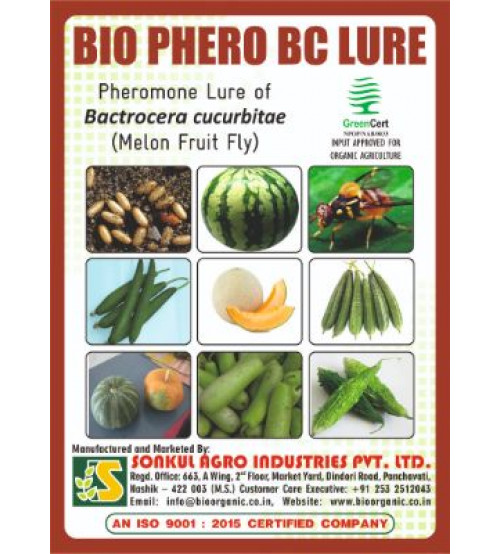

-202x224.jpg)
-202x224.jpg)
-202x224.jpg)
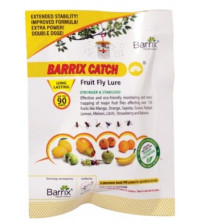
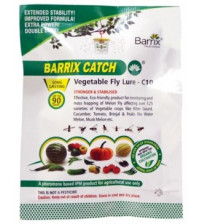
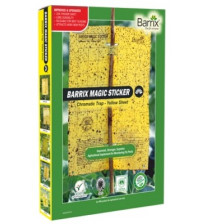
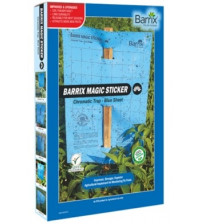
-202x224.png)
-202x224.png)
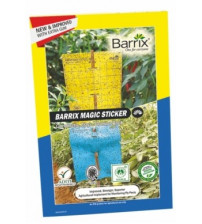
-202x224.jpg)
-202x224.png)
-202x224.png)
-202x224.png)
-202x224.jpg)
-202x224.png)
-202x224.png)
-202x224.jpg)
-202x224.png)
-202x224.png)
-202x224.png)
-202x224.png)
-202x224.png)
-202x224.png)
-202x224.png)
-202x224.png)
-202x224.png)
-202x224.jpg)
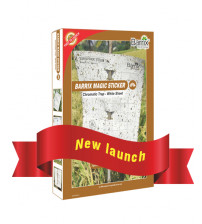
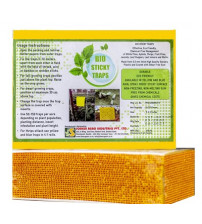
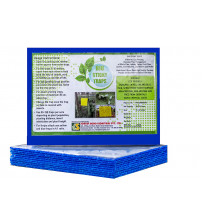
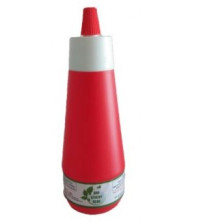
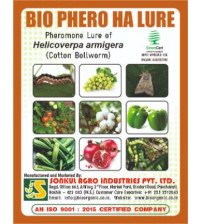
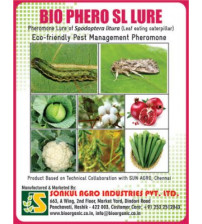
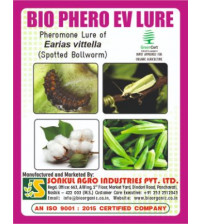
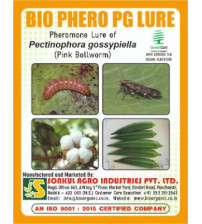
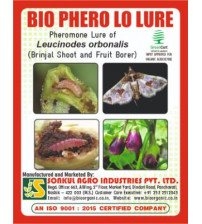
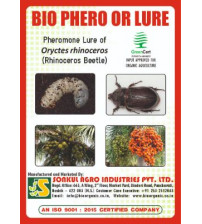
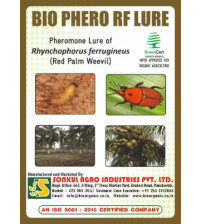

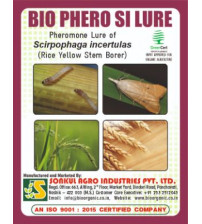
-202x224.jpg)
